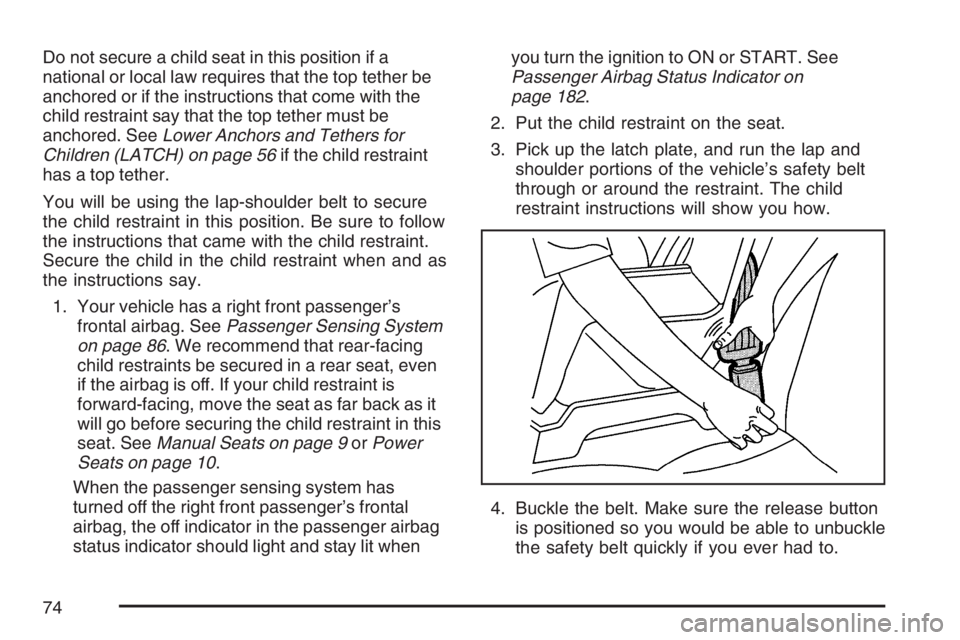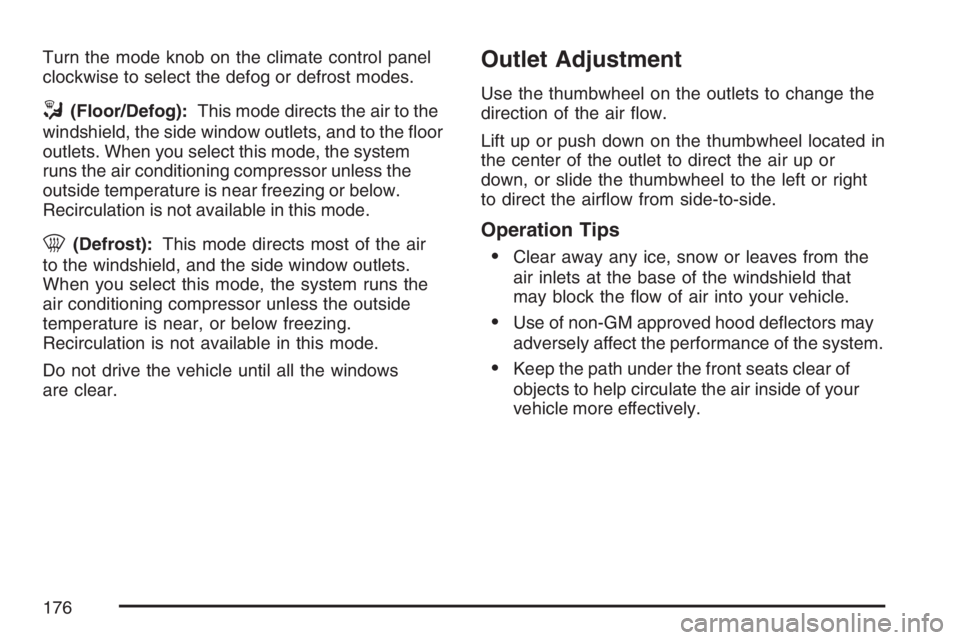Page 74 of 492

Do not secure a child seat in this position if a
national or local law requires that the top tether be
anchored or if the instructions that come with the
child restraint say that the top tether must be
anchored. SeeLower Anchors and Tethers for
Children (LATCH) on page 56if the child restraint
has a top tether.
You will be using the lap-shoulder belt to secure
the child restraint in this position. Be sure to follow
the instructions that came with the child restraint.
Secure the child in the child restraint when and as
the instructions say.
1. Your vehicle has a right front passenger’s
frontal airbag. SeePassenger Sensing System
on page 86. We recommend that rear-facing
child restraints be secured in a rear seat, even
if the airbag is off. If your child restraint is
forward-facing, move the seat as far back as it
will go before securing the child restraint in this
seat. SeeManual Seats on page 9orPower
Seats on page 10.
When the passenger sensing system has
turned off the right front passenger’s frontal
airbag, the off indicator in the passenger airbag
status indicator should light and stay lit whenyou turn the ignition to ON or START. See
Passenger Airbag Status Indicator on
page 182.
2. Put the child restraint on the seat.
3. Pick up the latch plate, and run the lap and
shoulder portions of the vehicle’s safety belt
through or around the restraint. The child
restraint instructions will show you how.
4. Buckle the belt. Make sure the release button
is positioned so you would be able to unbuckle
the safety belt quickly if you ever had to.
74
Page 75 of 492
5. Pull the rest of the shoulder belt all the way
out of the retractor to set the lock.
6. If your vehicle does not have rear seats and if
your child restraint has a top tether, attach the
top tether to the top tether anchor. SeeLower
Anchors and Tethers for Children (LATCH)
on page 56.7. To tighten the belt, push down on the child
restraint, pull the shoulder portion of the belt
to tighten the lap portion of the belt, and
feed the shoulder belt back into the retractor.
If you are using a forward-facing child
restraint, you may �nd it helpful to use your
knee to push down on the child restraint
as you tighten the belt. You should not be able
to pull more of the belt from the retractor
once the lock has been set.
8. Tighten the top tether to the anchor. SeeLower
Anchors and Tethers for Children (LATCH)
on page 56.
75
Page 93 of 492

Adding Equipment to Your
Airbag-Equipped Vehicle
Q:Is there anything I might add to the front
or sides of the vehicle that could keep
the airbags from working properly?
A:Yes. If you add things that change your
vehicle’s frame, bumper system, height,
front end or side sheet metal, they may keep
the airbag system from working properly.
Also, the airbag system may not work properly
if you relocate any of the airbag sensors.
If you have any questions about this,
you should contact Customer Assistance
before you modify your vehicle. The phone
numbers and addresses for Customer
Assistance are in Step Two of the Customer
Satisfaction Procedure in this manual.
SeeCustomer Satisfaction Procedure
on page 456.
Q:Because I have a disability, I have to get
my vehicle modi�ed. How can I �nd out
whether this will affect my airbag system?
A:Changing or moving any parts of the
front seats, safety belts, the airbag sensing
and diagnostic module, steering wheel,
instrument panel, ceiling headliner, ceiling
and pillar garnish trim, roof-mounted airbag
modules, or airbag wiring can affect the
operation of the airbag system. If you
have questions, call Customer Assistance.
The phone numbers and addresses for
Customer Assistance are in Step Two of
the Customer Satisfaction Procedure in
this manual. SeeCustomer Satisfaction
Procedure on page 456.
93
Page 150 of 492

Storage Areas
Glove Box
To open the glove box, pull on the lever.
Cupholder(s)
Your vehicle may have two cupholders located
on the lower part of the front doors as well as
two cupholders located at the front end of the
console. Vehicles with bench seats may have
cupholders attached to the front of the center seat.
If your vehicle is an extended cab or crew cab
model, your vehicle also has two rear cupholders.
On crew cab models, the cupholders are located
at the front end of the rear center seat cushion.
On extended cab models, the rear seat cupholders
are located on top of the rear center console.
If you have an ashtray, it will use one of the
cupholders.
Front Armrest Storage Area
For vehicles with bench seats, you may have a
center armrest storage area. Lift up on the upper
tab located at the front of the armrest to release
the latch. Lift the lid to open the storage area.For vehicles with bucket seats or uplevel
packages, your vehicle may have a two-tiered
center armrest storage area. Lift up on the upper
tab located at the front of the armrest to release
the latch. Lift the lid to the top storage area.
A second tab is located below the top one and
allows you to access the bottom storage area.
Lift up on the lower tab to release the latch.
Then, raise the lid of the lower storage area.
The upper storage area will lift up with the lid of
the lower storage area.
To close the storage area(s), lower the lid(s) until
you feel the latch close.
Assist Handles
Your vehicle may have assist handles to be used
when getting out of your vehicle. If your vehicle has
assist handles, they are located above the doors.
If your vehicle has roof-mounted side impact air
bags, there are assist handles located above both
the driver’s and front passenger’s doors.
150
Page 151 of 492
Rear Storage Area
If your vehicle is an extended cab model, it might
have storage compartments under the rear seats.
To access the storage compartments, lift the
cushion on the bottom of the rear seats. This
exposes the storage boxes under the seat.To open a storage box, unhook the bottom and lift
the two latches on each side of the storage box.
151
Page 171 of 492

Exit Lighting
With exit lighting, the interior lamps will come on
when you remove the key from the ignition.
The lamps will not come on if the dome override
button is pressed in.
Electric Power Management
The vehicle has Electric Power Management
(EPM) that estimates the battery’s temperature and
state of charge. It then adjusts the voltage for
best performance and extended life of the battery.
When the battery’s state of charge is low, the
voltage is raised slightly to quickly put the charge
back in. When the state of charge is high, the
voltage is lowered slightly to prevent overcharging.
If the vehicle has a voltmeter gage, you may
see the voltage move up or down. This is normal.
If there is a problem, an alert will be displayed.The battery can be discharged at idle if the
electrical loads are very high. This is true for all
vehicles. This is because the generator (alternator)
may not be spinning fast enough at idle to
produce all the power that is needed for very high
electrical loads.
A high electrical load occurs when several of the
following loads are on: headlamps, high beams,
fog lamps, rear window defogger, climate
control fan at high speed, heated seats, engine
cooling fans, trailer loads, and loads plugged into
accessory power outlets.
Battery Run-Down Protection
This feature shuts off the dome lamp if it is left on
for more than 20 minutes when the ignition is
in LOCK. This will help prevent your battery from
running down.
171
Page 176 of 492

Turn the mode knob on the climate control panel
clockwise to select the defog or defrost modes.
/(Floor/Defog):This mode directs the air to the
windshield, the side window outlets, and to the �oor
outlets. When you select this mode, the system
runs the air conditioning compressor unless the
outside temperature is near freezing or below.
Recirculation is not available in this mode.
0(Defrost):This mode directs most of the air
to the windshield, and the side window outlets.
When you select this mode, the system runs the
air conditioning compressor unless the outside
temperature is near, or below freezing.
Recirculation is not available in this mode.
Do not drive the vehicle until all the windows
are clear.
Outlet Adjustment
Use the thumbwheel on the outlets to change the
direction of the air �ow.
Lift up or push down on the thumbwheel located in
the center of the outlet to direct the air up or
down, or slide the thumbwheel to the left or right
to direct the air�ow from side-to-side.
Operation Tips
Clear away any ice, snow or leaves from the
air inlets at the base of the windshield that
may block the �ow of air into your vehicle.
Use of non-GM approved hood de�ectors may
adversely affect the performance of the system.
Keep the path under the front seats clear of
objects to help circulate the air inside of your
vehicle more effectively.
176
Page 291 of 492

{CAUTION:
Things you put inside your vehicle can
strike and injure people in a sudden stop
or turn, or in a crash.
Put things in the cargo area of your
vehicle. Try to spread the weight
evenly.
Never stack heavier things, like
suitcases, inside the vehicle so that
some of them are above the tops of
the seats.
Do not leave an unsecured child
restraint in your vehicle.
When you carry something inside the
vehicle, secure it whenever you can.
Do not leave a seat folded down
unless you need to.
There is also important loading information for
off-road driving in this manual. See“Loading Your
Vehicle for Off-Road Driving”underOff-Road
Driving on page 256.
Remember not to exceed the Gross Axle Weight
rating (GAWR) of the front or rear axle.
Two-Tiered Loading
By positioning four 2” X 6” wooden planks across
the width of the pickup box, you can create an
upper load platform. The planks must be inserted
in the pickup box depressions. The length of
the planks must allow for at least a 3/4 inch (2 cm)
bearing surface on each end of the plank.
When using this upper load platform, be sure the
load is securely tied down to prevent it from
shifting. The load’s center of gravity should be
positioned in a zone over the rear axle.
Any load that extends beyond the vehicle’s
taillamp area must be properly marked according
to local laws and regulations.
Remember not to exceed the Gross Axle Weight
Rating (GAWR) of the rear axle.
291